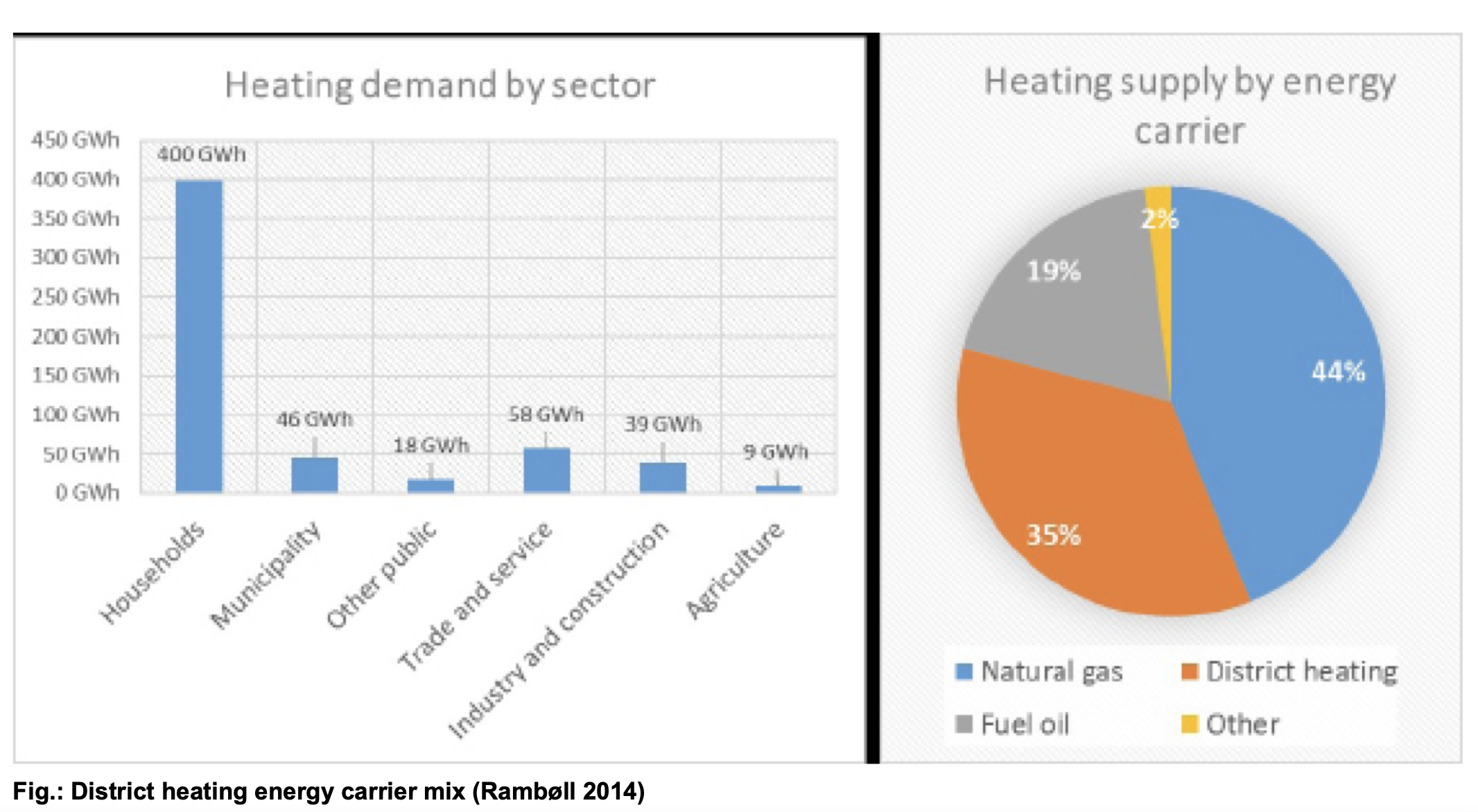Denmark
2017
- Type : Energy planning
- Size : Local community
- Area : Residential
Environmental benefit
Ensuring energy security and cost- efficient heat supply
Share
Denmark
2017
- Type : Energy planning
- Size : Local community
- Area : Residential
Environmental benefit
Discover this use case online

Results from scenarios and policy assessment
Two alternatives have been established for the years 2030 and 2050 respectively.
1. Scenario BIO2030 (Reference scenario)
• District heating based on a biomass CHP and a biomass boiler
• Individual supply based on various shares of: Biomass boilers, natural gas boilers and heat pumps.
2. Scenario HP2030
• District heating based on heat pumps and thermal storage • Individual supply based on various shares of: Biomass boilers, natural gas boilers and heat pumps.
3. Scenario BIO 2050 (Reference scenario)
• District heating based on a biomass CHP and a biomass boiler
• Individual supply based on various shares of: Biomass boilers, natural gas boilers and heat pumps.
4. Scenario Combi2050
• District heating based on heat pumps, thermal storage, solar heating and heat-only biomass boilers
• Individual supply based on various shares of: Biomass boilers, natural gas boilers and heat pumps.
The names of the scenarios relate to the technology used for district heating generation in Forsyning Helsingør, so only the competition with other supply options determines what the fuel mix for the individual supply will be in each scenario. In all scenarios, about 33 GWh of district heat generated from waste and natural gas is supplied yearly from the Norfors neighbouring.
Recommendations and possible solutions
The main recommendations for the Helsingør municipality are:
• Promoting heat savings in buildings
– A 40% heat saving can be reached in the municipality’s building stock. These savings can be achieved through information campaigns targeting owners of old buildings with a high energy demand and old buildings supplied with oil boilers.
• Promoting the shift from individual fossil heat supply, especially in regards to oil boilers The project has identified a number of buildings within and close to district heating areas supplied by oil boilers. These are ‘low-hanging fruits’ which should be converted to district heating.
• Discouraging the installation of individual biomass boilers in densely-populated areas through information campaigns
• Ensuring cheap, CO2-neutral DH from Forsy- ning Helsingør by looking into future investment in profitable RES solutions such as large heat pumps
• Advocating for a shift to fossil-free district heating – if continued import from Norfors.
 R-ACES has received funding from the European Union’s Horizon 2020 research and innovation programme under grant agreement N° 892429
R-ACES has received funding from the European Union’s Horizon 2020 research and innovation programme under grant agreement N° 892429
Results from scenarios and policy assessment
Two alternatives have been established for the years 2030 and 2050 respectively.
1. Scenario BIO2030 (Reference scenario)
• District heating based on a biomass CHP and a biomass boiler
• Individual supply based on various shares of: Biomass boilers, natural gas boilers and heat pumps.
2. Scenario HP2030
• District heating based on heat pumps and thermal storage • Individual supply based on various shares of: Biomass boilers, natural gas boilers and heat pumps.
3. Scenario BIO 2050 (Reference scenario)
• District heating based on a biomass CHP and a biomass boiler
• Individual supply based on various shares of: Biomass boilers, natural gas boilers and heat pumps.
4. Scenario Combi2050
• District heating based on heat pumps, thermal storage, solar heating and heat-only biomass boilers
• Individual supply based on various shares of: Biomass boilers, natural gas boilers and heat pumps.
The names of the scenarios relate to the technology used for district heating generation in Forsyning Helsingør, so only the competition with other supply options determines what the fuel mix for the individual supply will be in each scenario. In all scenarios, about 33 GWh of district heat generated from waste and natural gas is supplied yearly from the Norfors neighbouring.
Recommendations and possible solutions
The main recommendations for the Helsingør municipality are:
• Promoting heat savings in buildings
– A 40% heat saving can be reached in the municipality’s building stock. These savings can be achieved through information campaigns targeting owners of old buildings with a high energy demand and old buildings supplied with oil boilers.
• Promoting the shift from individual fossil heat supply, especially in regards to oil boilers The project has identified a number of buildings within and close to district heating areas supplied by oil boilers. These are ‘low-hanging fruits’ which should be converted to district heating.
• Discouraging the installation of individual biomass boilers in densely-populated areas through information campaigns
• Ensuring cheap, CO2-neutral DH from Forsy- ning Helsingør by looking into future investment in profitable RES solutions such as large heat pumps
• Advocating for a shift to fossil-free district heating – if continued import from Norfors.
